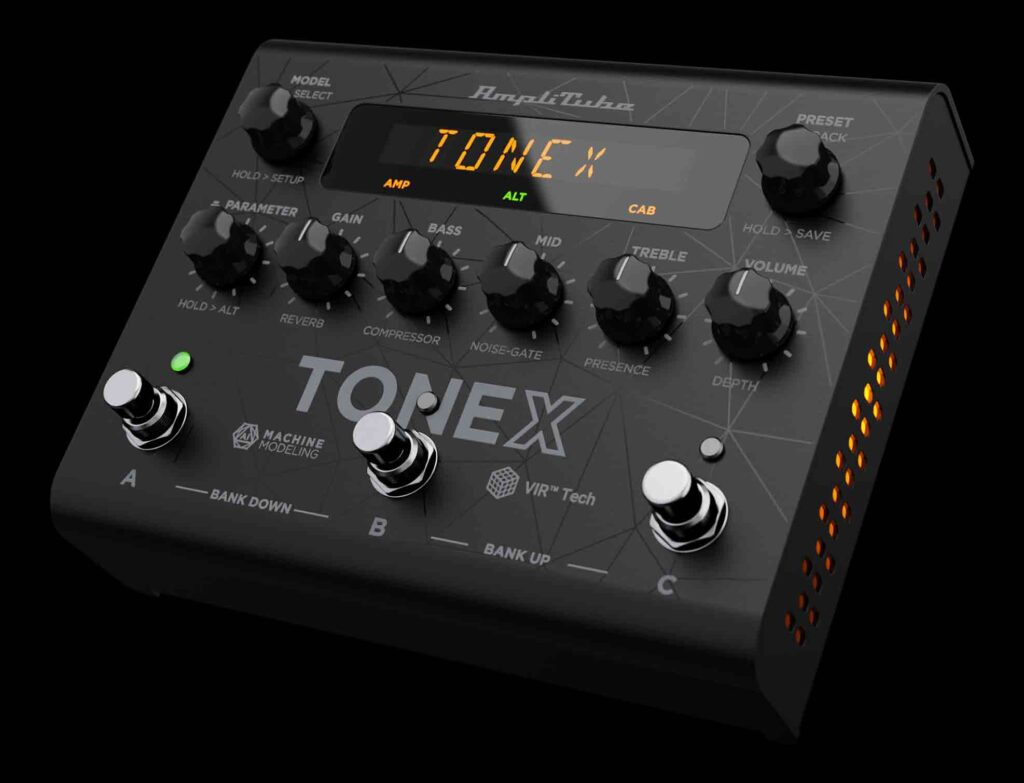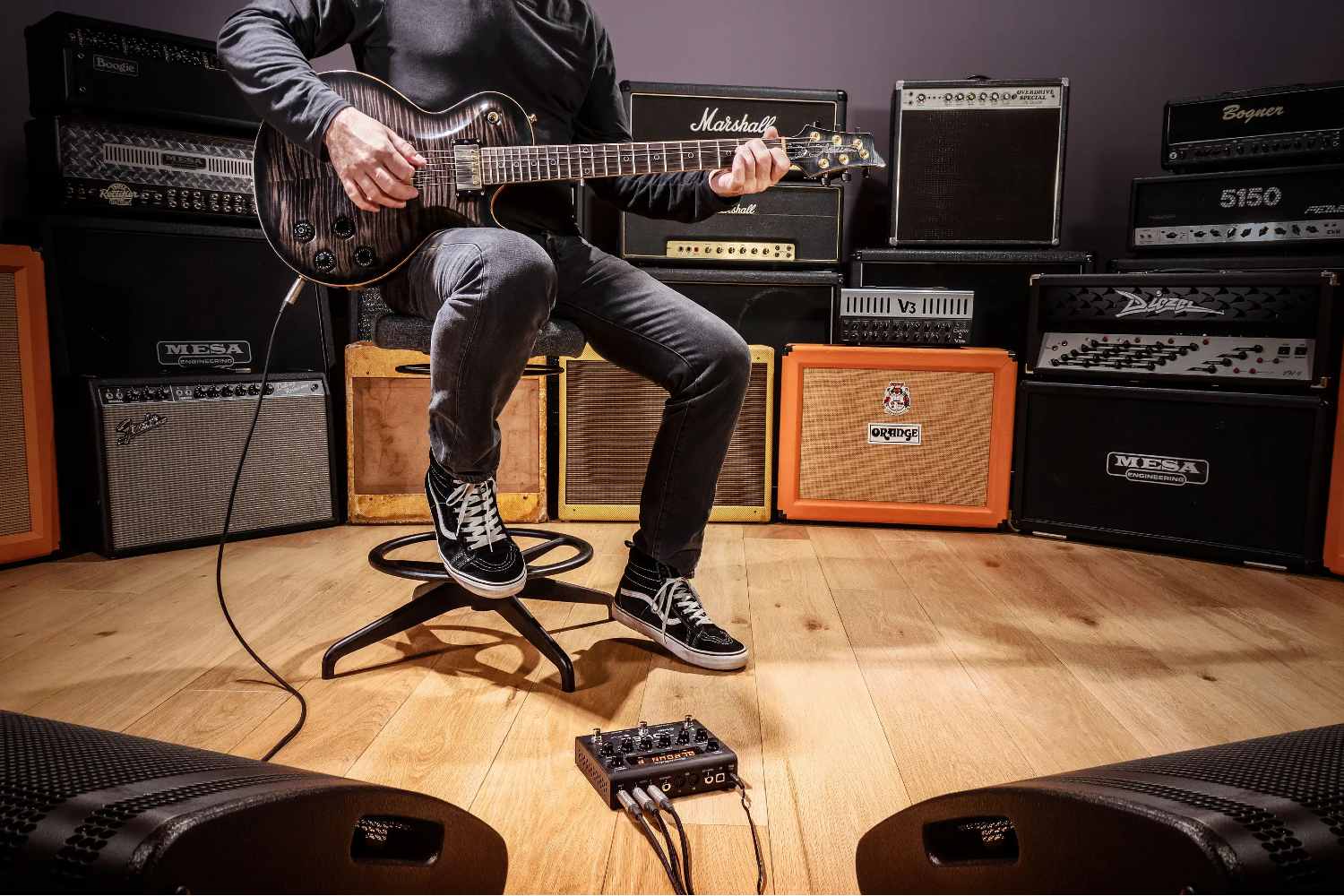The IK Multimedia TONEX has entered the physical world in the form of this pedal. So what does TONEX do, and what makes it different to all the other modellers out there?
There are so many amp sim plugins, digital modellers, profilers, analog options like the venerable SansAmp… you would almost expect that at this point in guitar history, everything would pretty much sound the same and do the same thing, since all these devices make it a point to recreate many of the same specific classic amps. What is there left to even do?
Read more gear reviews here.
IK Multimedia has offered their answer in the form of TONEX. TONEX is many things. Originally it was released as a desktop app and plugin for your DAW, a sort of next step from their pioneering AmpliTube all-in-one amp-and-effects solution, but only focusing on the amps. Then it came out as an iOS app. And now, finally, TONEX has entered the physical world in the form of this pedal. What does TONEX do, and what makes it different to all the other modellers out there?
TONEX – the technology – employs machine modelling to build incredibly accurate profiles of amps and gain pedals. Using an audio interface and the TONEX software, you can capture your favourite amp tone, your favourite gain pedal (distortion, fuzz, overdrive, boost, EQ – it’ll even have a good go at specific compressor settings) and upload it to share with the TONEX community, where they can download it to their own software, or now, to the TONEX Pedal to take anywhere. There are 1000 downloadable premium Tone Models provided by IK Multimedia using everything from Marshalls and Fuzz Faces to Twins and DS-1s, 5150s and Tube Screamers and all the other classic combos, right down to a whole suite of models of a Dumble amp in the IK collection. And there’s a huge TONEX community sharing their own presets. (If you go online you might even find my DigiTech Bad Monkey model, which I uploaded a few weeks before the infamous video that sent the price of the Bad Monkey through the roof).

The TONEX Pedal features controls for Gain, Bass, Mid, Treble and Volume, as well as a few knobs for selecting models, storing presets and tweaking further parameters, such as Reverb, Compression, Noise Gate, Presence and Depth. You can store presets in banks of three which you can access through the three sturdy foot switches, and there are stereo outputs, MIDI jacks and a foot switch jack for integrating in all sorts of rigs. The pedal itself is very tough and would certainly withstand the rigours of the road or the angriest airline baggage handler. It also doubles as a high-quality USB audio interface, has ultra-low-noise 24-bit 192 kHz converters, a 5 Hz-24kHz frequency response, and 123dB dynamic range. In other words, it’s a serious piece of kit. Some players have expressed confusion online as to why the TONEX Pedal doesn’t have an effects loop: the answer is, it doesn’t need one. Just pop your time-based effects after TONEX in the signal chain. Put your gain effects before it. Don’t overcomplicate things, dude. You can always bypass the unit’s cabinet IR section, follow it up with whatever delays and reverbs you like then go into some other IR unit if it’s that important to you.
So, given that it can replicate any amp, dirt box and combination thereof that you feed it, the question is ‘How well does it do it, and how does it feel?’ The answer is, since I first tried TONEX in my DAW, I’ve stopped recording my Marshall DSL50, because a user DSL50 profile I found online sounds and feels so much like my amp that I can’t tell the difference. It responds to changes in guitar pickup settings or volume control levels just like my real amp does, and the included reverb options (including several Spring, Plate and Room types) help to add some dimensionality in a way that feels ultra-realistic. And the expanded controls give you the ability to tweak frequencies and fine-tune your models in ways that the original gear just couldn’t do.
So what it all comes down to is the quality not of TONEX’s modelling itself, but the capabilities of the person making a model. The TONEX app guides you very clearly through the process, but if you use a bad-sounding mic or just bad mic technique to create a model, or you overdo or under-cook the input gain, you might not achieve your desired result.
The Dumble profiles are amazing. The stomp boxes really sound like the stomp boxes they’re modelling. And the list of profiles is expanding daily as more players upload their creations.
The TONEX Pedal does things that other modellers just don’t do, in terms of the faithfulness of its profiles and the ease of use once you’ve got them into your pedal. It’s the kind of thing you can use with a pedalboard power amp such as a Seymour Duncan PowerStage, or into your amp’s power amp in, or straight into a mixing desk, and have the whole history of guitar and bass amps right there at your feet. Yeah, there are other modellers out there, and they all do their thing in their own way, but IK has really nailed the user experience along with the feel, and that’s why this pedal deserves to sit among the biggest names in modelling.
For more information, head to IK Multimedia. For local enquiries, visit Sound and Music.

